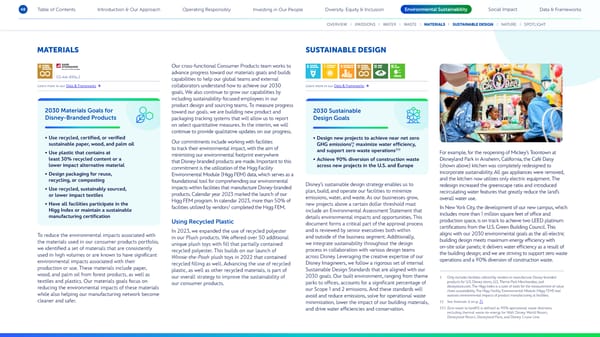48 Table of Contents Introduction & Our Approach Operating Responsibly Investing in Our People Diversity, Equity & Inclusion Environmental Sustainability Social Impact Data & Frameworks OVERVIEW EMISSIONS WATER WASTE MATERIALS SUSTAINABLE DESIGN NATURE SPOTLIGHT MATERIALS SUSTAINABLE DESIGN Our cross-functional Consumer Products team works to advance progress toward our materials goals and builds CG-AA-430a.2 capabilities to help our global teams and external Learn more in our Data & Frameworks collaborators understand how to achieve our 2030 Learn more in our Data & Frameworks goals. We also continue to grow our capabilities by including sustainability-focused employees in our product design and sourcing teams. To measure progress 2030 Materials Goals for toward our goals, we are building new product and 2030 Sustainable Disney-Branded Products packaging tracking systems that will allow us to report Design Goals on select quantitative measures. In the interim, we will continue to provide qualitative updates on our progress. • Use recycled, certi昀椀ed, or veri昀椀ed Our commitments include working with facilities • Design new projects to achieve near net zero sustainable paper, wood, and palm oil †† GHG emissions maximize water ef昀椀ciency, to track their environmental impact, with the aim of , ††† • Use plastic that contains at minimizing our environmental footprint everywhere and support zero waste operations For example, for the reopening of Mickey’s Toontown at least 30% recycled content or a that Disney-branded products are made. Important to this • Achieve 90% diversion of construction waste Disneyland Park in Anaheim, California, the Café Daisy lower impact alternative material commitment is the utilization of the Higg Facility across new projects in the U.S. and Europe (shown above) kitchen was completely redesigned to • Design packaging for reuse, Environmental Module (Higg FEM) data, which serves as a incorporate sustainability. All gas appliances were removed, recycling, or composting foundational tool for comprehending our environmental Disney’s sustainable design strategy enables us to and the kitchen now utilizes only electric equipment. The • Use recycled, sustainably sourced, impacts within facilities that manufacture Disney-branded plan, build, and operate our facilities to minimize redesign increased the greenscape ratio and introduced or lower impact textiles products. Calendar year 2023 marked the launch of our emissions, water, and waste. As our businesses grow, recirculating water features that greatly reduce the land’s • Have all facilities participate in the Higg FEM program. In calendar 2023, more than 50% of new projects above a certain dollar threshold must overall water use. † Higg Index or maintain a sustainable facilities utilized by vendors completed the Higg FEM. include an Environmental Assessment Statement that In New York City, the development of our new campus, which manufacturing certi昀椀cation details environmental impacts and opportunities. This includes more than 1 million square feet of of昀椀ce and Using Recycled Plastic document forms a critical part of the approval process production space, is on track to achieve two LEED platinum In 2023, we expanded the use of recycled polyester and is reviewed by senior executives both within certi昀椀cations from the U.S. Green Building Council. This To reduce the environmental impacts associated with in our Plush products. We offered over 50 additional and outside of the business segment. Additionally, aligns with our 2030 environmental goals as the all-electric the materials used in our consumer products portfolio, unique plush toys with 昀椀ll that partially contained we integrate sustainability throughout the design building design meets maximum energy ef昀椀ciency with we identi昀椀ed a set of materials that are consistently recycled polyester. This builds on our launch of process in collaboration with various design teams on-site solar panels; it delivers water ef昀椀ciency as a result of used in high volumes or are known to have signi昀椀cant Winnie-the-Pooh plush toys in 2022 that contained across Disney. Leveraging the creative expertise of our the building design; and we are striving to support zero waste environmental impacts associated with their recycled 昀椀lling as well. Advancing the use of recycled Disney Imagineers, we follow a rigorous set of internal operations and a 90% diversion of construction waste. production or use. These materials include paper, plastic, as well as other recycled materials, is part of Sustainable Design Standards that are aligned with our wood, and palm oil from forest products, as well as our overall strategy to improve the sustainability of 2030 goals. Our built environment, ranging from theme † Only includes facilities utilized by vendors to manufacture Disney-branded textiles and plastics. Our materials goals focus on our consumer products. parks to of昀椀ces, accounts for a signi昀椀cant percentage of products for U.S. Disney stores, U.S. Theme Park Merchandise, and reducing the environmental impacts of these materials our Scope 1 and 2 emissions. And these standards will disneystore.com. The Higg Index is a suite of tools for the measurement of value while also helping our manufacturing network become chain sustainability. The Higg Facility Environmental Module (Higg FEM) tool avoid and reduce emissions, solve for operational waste assesses environmental impacts of product manufacturing at facilities. cleaner and safer. minimization, lower the impact of our building materials, †† See footnote 6 on p. 71. and drive water ef昀椀ciencies and conservation. ††† Zero waste to land昀椀ll is de昀椀ned as 90% operational waste diversion, including thermal waste-to-energy for Walt Disney World Resort, Disneyland Resort, Disneyland Paris, and Disney Cruise Line.
 Disney 2023 Sustainability & Social Impact Report Page 47 Page 49
Disney 2023 Sustainability & Social Impact Report Page 47 Page 49